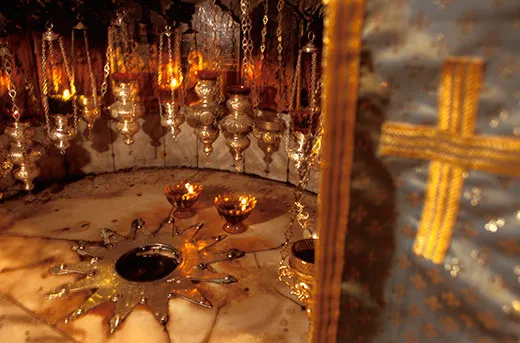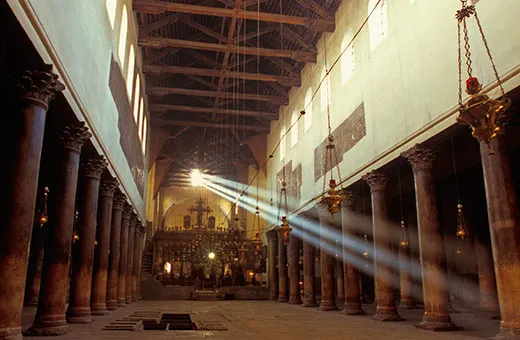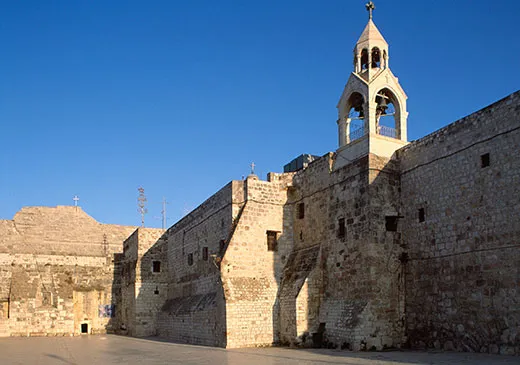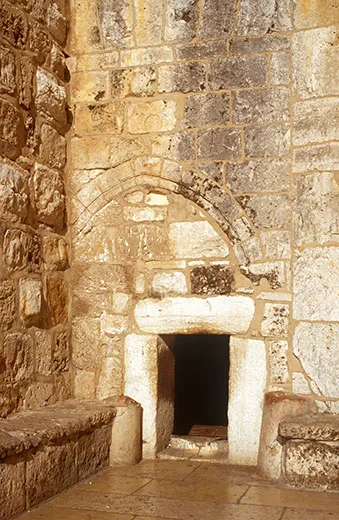Endangered Site: Church of the Nativity, Bethlehem
The basilica believed to mark the birthplace of Jesus Christ has survived invasions, rebellions and earthquakes
/https://tf-cmsv2-smithsonianmag-media.s3.amazonaws.com/filer/Church-of-the-Holy-Nativity-631.jpg)
Feuding monks at the Church of the Nativity in Bethlehem don't just cast the first stone—they stockpile rocks in anticipation of future altercations. Several holy men landed in the hospital two Christmases ago after a fight broke out over the dusting of church chandeliers. The occasional brawls at the 1,700-year-old basilica, believed to mark the birthplace of Jesus Christ, reflect the difficulty of housing three Christian denominations under a single roof.
And now that roof is rotting, threatening the structural integrity of the building. Parts of the wooden truss structure date to the 15th century, and holes in the timbers allow dirty water to drip upon the precious paintings and mosaics below. The problem has been worsening for decades, but the resident clerics—from the Greek Orthodox and Armenian Orthodox churches and the Franciscan order of the Roman Catholic Church—are jealous of each other's claims of custody and have been unable to agree on a plan of action. Despite the Palestinian Authority's recent effort to intervene, historians despair of saving the place.
"It is in the direst need of the greatest care," says Jaroslav Folda, a University of North Carolina professor emeritus of art history who studies the Crusader paintings on the basilica's red limestone columns. "This church is one of the holiest sites in Christianity. It is the victim here."
The fortresslike basilica is one of the oldest continuously operating churches in the world, having survived—some would say miraculously—various invasions, regime changes, fires, earthquakes and, most recently, the 2002 siege of Bethlehem, when armed Palestinians hid in the church from Israeli forces for weeks. Some wonder if the church has been spared only to be destroyed by the people who cherish it the most. The atmosphere of hostility "taints the holy place," says the Rev. Jerome Murphy-O'Connor, a Roman Catholic priest who teaches archaeology at the École Biblique in Jerusalem.
Mahmoud Abbas, president of the Palestinian Authority, which controls Bethlehem, promised last November that his government would help organize a roof restoration effort and set up a fund for donations. But money isn't the issue. In fact, all three churches seem to want the historic privilege of picking up at least part of the tab, as a means of edging out the competition.
The Church of the Nativity was built around A.D. 330 by the first Christian Roman Emperor Constantine and was mostly destroyed—possibly during a Samaritan rebellion in A.D. 529—though parts of the original mosaic floor remain. Soon after, the Byzantine Emperor Justinian rebuilt the church in a bigger, grander fashion—largely the structure that remains today. In A.D. 614, the Persians, who razed many other churches during wars with Byzantium, spared the Church of the Nativity, supposedly out of respect for a mosaic of the Magi shown wearing Persian attire.
When the Crusaders conquered the Holy Land in 1099, they sent a force of 100 knights to guard the church; eventually, artists from this era embellished the building with their own mosaics and column paintings of saints, done in the rare encaustic method, with pigment suspended in wax.
Political control of Bethlehem has flip-flopped many times since. (The church's famous entrance, the four-foot-high "Door of Humility," was built not to make pilgrims bow but rather to repel looters on horse- and camel-back after the Crusades.) The question of which Christians had the rights to what parts of the church eventually got so tense that the Ottoman sultans, who ruled over Palestine from the 1500s through World War I, instigated an unwritten system now known as the Status Quo, which mandates that things be done as they were always done. Anyone who has previously processioned down a certain aisle, used a particular cupboard or hung a given tapestry has exclusive rights to that task or item.
However, if someone else manages to use or care for an object, ownership passes to them.
"You know, 'If you break it, you buy it'?" says Adam Porter, an associate professor of religion at Illinois College. "Well, this is, 'If you clean it, you own it.'"
The highly publicized fight at Christmas two years ago was essentially a territorial dispute. The Greeks were cleaning an Armenian-controlled part of the church, and custom dictated that they could dust the chandeliers by standing on a ladder set up in an appointed place. But the Greeks tried to move their ladder, encroaching on Armenian turf.
"Well," says Raymond Cohen, an international relations professor at Hebrew University of Jerusalem, "they had to know this was like waving a red rag in front of a bull."
Religious officials in the region say that what seem like petty scuffles are part of a larger struggle.
"Our concern would be if we stood back and did not try to defend the rights of two billion Catholics," says the Rev. Garret Edmunds, a Franciscan friar who is the Vice Commissary of the Holy Land in Washington, D.C. and lives in Jerusalem for half the year. "Even things less consequential than replacing a roof, like cleaning a step, are important. If the [Greek Orthodox] were allowed to repair the roof without complaint or concern, 100 years from now they could say, 'In 2008, we paid for the roof and that is a sign of our ownership.'"
Cohen says the Palestinian Authority's intervention is a promising sign—not because of the funds it might raise, but because it represents outside leadership. He wrote a book about another charged restoration project at the Church of the Holy Sepulchre in Jerusalem, which was badly damaged after a 1927 earthquake. With later supervision from the Jordanian government, the custodial churches were able to begin negotiations, which lasted a mere ten years.
"Do I think the repairs [to the Church of the Nativity] will happen in the near future? I don't, but you have to start somewhere," Cohen says. "Sometimes the behavior is so childish—you can't believe these are grown men. You've got to knock heads together and say, 'Guys, we're taking charge.' "



